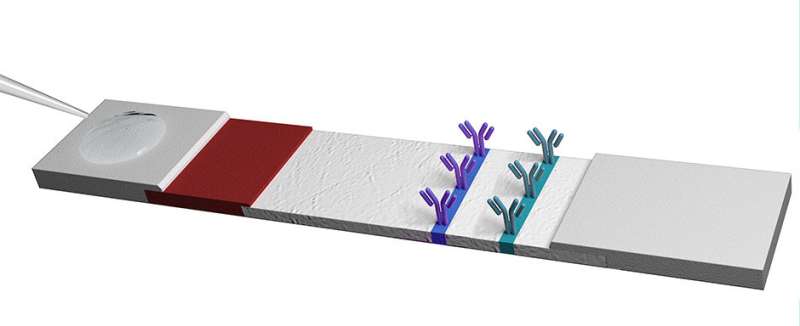Cellulose nanofibers to improve the sensitivity of lateral flow tests

Scientists from the ICN2 Nanobioelectronics and Biosensors Group led by ICREA Prof. Arben Merkoçi have carried out a study to enhance the sensitivity of lateral flow tests. They included cellulose nanofibers in the test area, producing an average increase of 36.6 percent of the colorimetric signal on positive tests. The proposed modification can be easily applied to any kind of lateral flow strip, enabling its use in point-of-care applications.
Lateral flow tests are used across a wide range of sectors, including human health and pharma, environmental testing, animal health, food and feed testing, and plant and crop health. They are paper-based biosensors that fulfill the demands of the World Health Organization's ASSURED criteria for devices, requiring them to be affordable, sensitive, selective, user-friendly, rapid and robust, and derivable to the end-user. Paradoxically, sensitivity is not always assured.
Their function is simple: A fluid sample, with or without a specific analyte, is applied to one end of the strip. Certain particles (transducers) prepared to attach to that analyte are dragged along by the fluid. Antibodies in large amounts are applied to the test line to retain the analyte marked with the transducers. If the analyte is present in the sample, the test line will be colored because of the transducers. Otherwise, the particles will continue their journey to the end of the strip.
Researchers from the ICN2, in collaboration with University of Girona, report a way to increase the sensitivity of the test with only a slight increase in time. The results are published in Biosensors and Bioelectronics by first author Dr. Daniel Quesada-González, now researcher at the spin-off Paperdopdx.
One way to enhance the sensitivity of the strips has to do with their porosity. If the pores are big enough, the transducers may go through them instead of stopping in the test line, decreasing sensitivity. If the pores are too small, sensitivity increases, but the sample will flow more slowly.
The new research proposes to decrease the pore size only on the test area by including cellulose nanofibers in that zone. They are biocompatible with antibodies, thus increasing the areas where they can be placed on the surface of the strip, where the color of the transducer particles is best appreciated. Thanks to this modification, the researchers observed an average increase of 36.6 percent of the colorimetric signal, meaning that more transducer particles were retained in the test line. They have also demonstrated that this retention is only due to the interaction of the analytes with the antibodies, not because of any interactions of the transducers with cellulose nanofibers, which avoids false positives.
This strategy could be used to discriminate better between similar concentrations of a given analyte, which is useful, especially on diagnostic applications. The higher level of sensitivity allows a quantitative analysis of the samples using a simple camera device like the ones integrated in smartphones. The proposed modification is cheap and can be easily applied, enabling its use in point-of-care applications.
More information: Daniel Quesada-González et al. Signal enhancement on gold nanoparticle-based lateral flow tests using cellulose nanofibers, Biosensors and Bioelectronics (2019). DOI: 10.1016/j.bios.2019.111407
Journal information: Biosensors and Bioelectronics




















